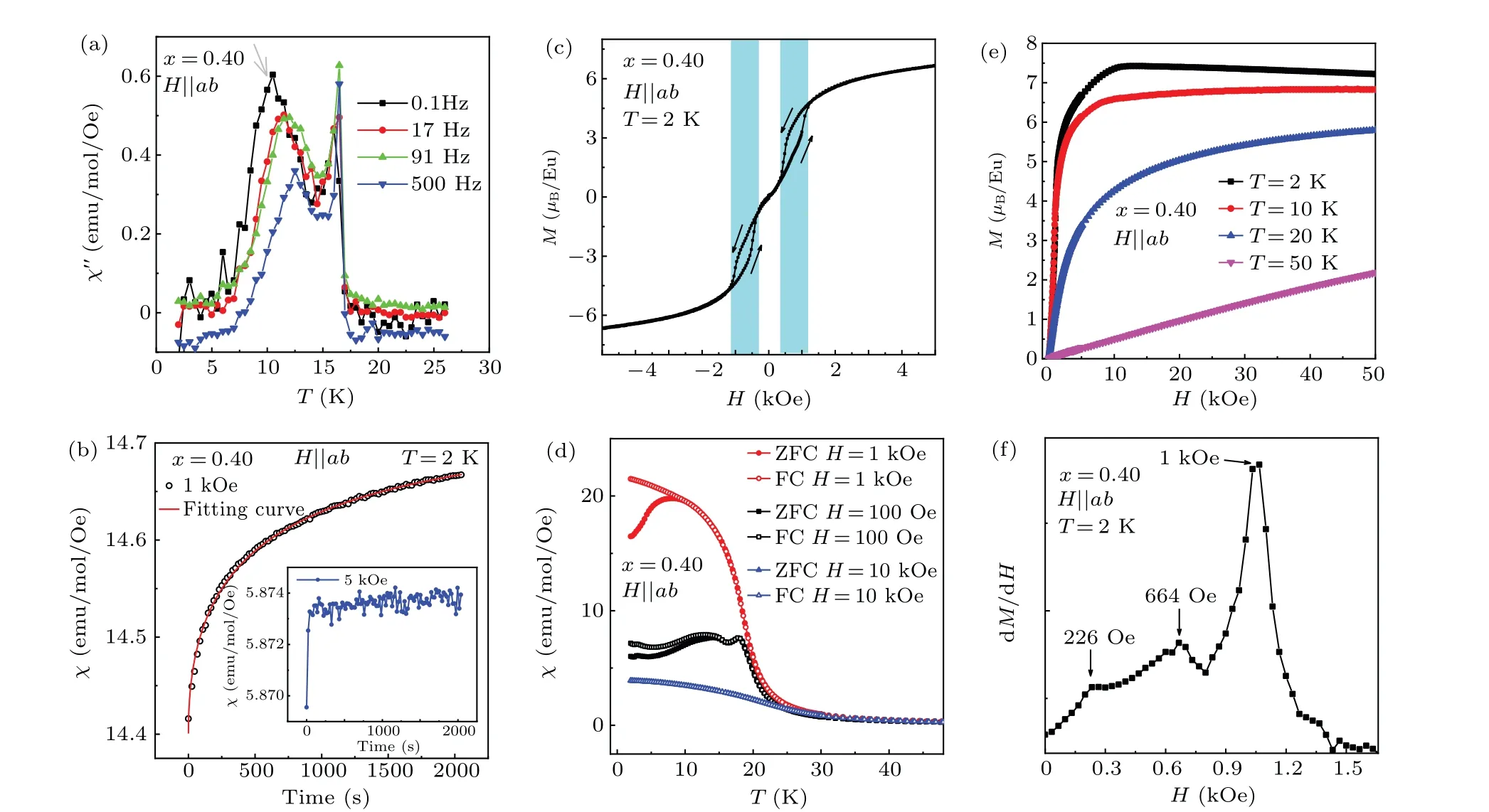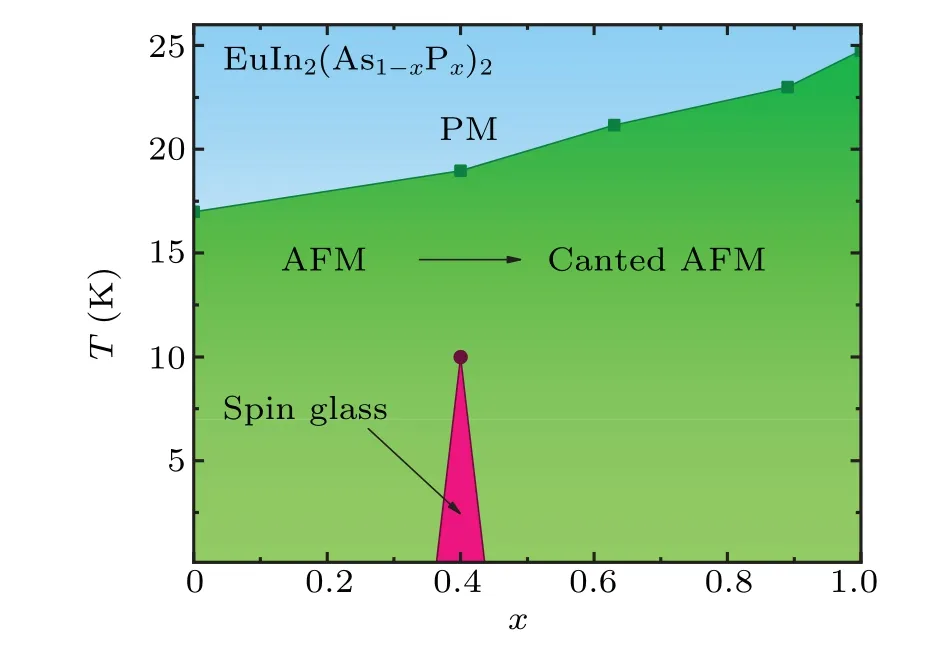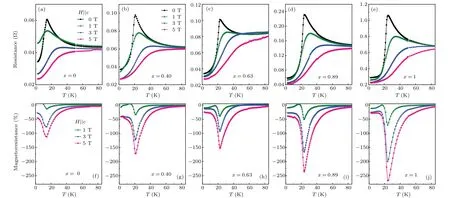Effects of phosphorus doping on the physical properties of axion insulator candidate EuIn2As2
2022-05-16FeihaoPan潘斐豪CongkuanTian田丛宽JialeHuang黄嘉乐DayeXu徐大业JinchenWang汪晋辰PengCheng程鹏JuanjuanLiu刘娟娟andHongxiaZhang张红霞
Feihao Pan(潘斐豪), Congkuan Tian(田丛宽), Jiale Huang(黄嘉乐), Daye Xu(徐大业),Jinchen Wang(汪晋辰), Peng Cheng(程鹏), Juanjuan Liu(刘娟娟), and Hongxia Zhang(张红霞)
Laboratory for Neutron Scattering and Beijing Key Laboratory of Optoelectronic Functional Materials and MicroNano Devices,Department of Physics,Renmin University of China,Beijing 100872,China
Keywords: axion topological insulator
1. Introduction
Topological materials with intrinsic magnetic order may host novel quantum states such as axion topological insulator(ATI)state with topological magnetoelectric effect.[1–3]Therefore extensive efforts have been devoted in search for such materials both theoretically and experimentally.[4–11]Current researches are limited to very few classes of materials, such as the Mn–Bi–Te layered compounds.[12–19]Although many exotic magnetic and electronic states with various topological phase transitions were reported, the experimental realization of ATI phase is still controversial.[20–24]
Recently, two-dimensional layered material EuIn2As2was theoretically proposed to be a candidate material of axion insulator with antiferromagnetic (AFM) long-range order.[5]Interestingly,the nontrivial topological state is closely related to its the magnetic ordering state. First-principles calculations show that EuIn2As2is a topological crystalline insulator if the moments of Eu lie in thea- orb-axis and a high-order topological insulator if the moments are alongc-axis. They can all host ATI states.[5]Experimentally, the orientation of the magnetic moment for the ground state of EuIn2As2is determined to be within theab-plane through magnetic and transport measurements.[25]Angle-resolved photoemission spectroscopy (ARPES) revealed a band reconstruction associated with the antiferromagnetic (AFM) transition together with a signature of bulk-band inversion in the AFM phase, consistent with the band calculation that supports the axion insulator phase.[26,27]Moreover, a neutron scattering investigation reveals a complex helical antiferromagnetic order in EuIn2As2different from the collinear AFM order predicted before.[28]Since different magnetic structure may induce different topological states,it would be important for exploring the ways to tune the magnetic order in EuIn2As2. Chemical doping has been proved to be an effective method to tune the physical properties of magnetic materials.[29,30]A very recent experimental work showed that, in Ca-doped EuIn2As2, the carrier density of electrons is significantly enhanced and while the intrinsic magnetic order in this system is maintained.[31]This work also mentioned an unsuccessful try to dope phosphorus(P) into EuIn2As2.[31]In this paper, we report the successful doping of P into EuIn2As2. High-quality single crystals of EuIn2(As1-xPx)2can be obtained fromx=0 tox=1 and thec-axis lattice parameter continuously decreases. The magnetic properties and the magnetoresistance can be effectively tuned by P-doping and a spin-glass state is found forx=0.40. Our results indicate that EuIn2(As1-xPx)2can serve as a new material playground for further investigations and provide useful information for realizing the nontrivial topological state in this system.
2. Experimental methods
The single crystals of EuIn2(As1-xPx)2were grown by flux method similar to previous reports.[32]A molar ratio of Eu:In:As:P = 1:12:3x:3(1-x) (nominal doping concentrationx=0.00, 0.25, 0.50, 0.75, 1.00) was used, where In in large excess serves as the flux. All reagents were handled in a Ar-filled glove box. For each reaction,all elements were mixed in an alumina crucible with half the indium flux loaded on the bottom and half on top of the rest of the reactants. The crucible, sandwiched between two layers of tightly packed quartz wool,was subsequently sealed under a 1/5 atmosphere of argon in a fused silica ampule. The reaction vessel was heated at the rate of 60°C/h to 1100°C and maintained at this temperature for 12 h before it was slow-cooled to 700°C at a rate of 2°C/h in a box furnace.The ampule was removed from the furnace at 700°C,inverted,and centrifuged to remove the molten indium flux.Black plate-like EuIn2(As1-xPx)2crystals with typical dimensions of 2×1×0.1 mm2could be obtained.
X-ray diffraction (XRD) patterns of single crystals were collected from a Bruker D8 Advance x-ray diffractometer using CuKαradiation. The elemental doping composition was measured by energy dispersive x-ray spectroscopy(EDS,Oxford X-Max 50). Magnetization measurements were carried out in Quantum Design MPMS3 and electric transport measurements were performed on PPMS-14T.
3. Results and discussion
The elemental compositions of all single crystals were measured by EDS and the results are consistent with the formation of Eu-122 phase. The doping concentrationxdetermined by EDS deviates from the nominal one to some extent,so all thexreferred to in this paper follows the EDS results.It should be noted that the EDS result also reveals a homogeneous distribution ofxfor these crystals and no possible phase separations could be identified. Single crystals with five typical doping concentration (x=0, 0.40, 0.63, 0.89 and 1)were selected for further measurements. Figure 1(a) shows the XRD patterns from theab-plane of these single crystals.The results are consistent with previous reports on EuIn2As2and EuIn2P2,[32,33]no impurities could be identified.
Figure 1(b)plots thec-lattice parameters as a function ofx. Thec-lattice parameter decreases linearly with increasingx,which is consistent with the successful doping of P into the lattice of EuIn2As2.Apparently,partial substitution of As with P generates chemical pressure to this system and results in the shrinkage of EuIn2As2lattice along thec-axis.
The results of DC magnetization measurements on EuIn2(As1-xPx)2are shown in Fig.2. For undoped EuIn2As2,the temperature dependent magnetic susceptibilityχ(T)under 1 kOe exhibits an AFM-like cusp atTN=16 K for bothH‖abandH ‖c,supporting an AFM ground state same as previous reports.[32]The isothermal magnetizationM(H)at 2 K shows that EuIn2As2can be fully polarized to a ferromagnetic state withH >10 kOe when the magnetic field is applied withinab-plane. The saturation field forH ‖cis much bigger than that needed forH ‖ab, confirming that EuIn2As2is an easyplane magnetic material. This easy-plane magnetic anisotropy is observed for all P-doped samples as revealed from isothermal magnetization [Figs. 2(f)–2(j)]. It should be noted that demagnetization corrections have been applied on theH ‖cdata andHintis the internal field. The saturation moments for EuIn2(As1-xPx)2are all close to 7.3μB/Eu which is almost doping independent and consistent with the theoretical value for a free Eu2+.
The magnetic properties of EuIn2(As1-xPx)2can be effectively tuned by doping concentrationx. Forx=0.40, the magnetic transition temperature increases to 18 K, which is determined as the temperature at whichχc(T) has an cusplike feature and dχab/dThas an minimum[inset of Fig.2(b)].Interestingly, a bifurcation between zero-field-cooling (ZFC)and field-cooling(FC)χab(T)curves is observed atTg=10 K which indicates the emergence of a spin-glass behavior.[34,35]With more P-doping, it can be seen that the cusp-like feature disappear inχab(T)underH=1 kOe. Nevertheless,the minimum of dχab/dTstill exists and occurs at the sample temperature with the cusp-like feature inχc(T) curves. Therefore the magnetic tranistion temperatureTMat higher doping level can still be determined by this method and it increases toTM=24 K forx=0.89 andx=1. Furthermore, the initial isothermal magnetization has a very sharp increase versus field atT=2 K andH‖abforx≥0.63 compared to undoped EuIn2As2, as marked by the black arrows in Figs. 2(h)–2(j).This is an indication of enhanced ferromagnetic interactions withinab-plane. Recently, the increased magnetic transition temperature and the enhancement of intralayer ferromagnetic exchange coupling are also observed in EuIn2As2by means of high pressure.[36]So the doping of P can somehow demonstrate the high pressure effect on EuIn2As2.

Fig.1. (a)XRD patterns from the ab-plane of EuIn2(As1-xPx)2 single crystals at room temperature. (b)The doping dependent c-axis lattice parameters for EuIn2(As1-xPx)2.

Fig.2. Temperature dependent magnetic susceptibilities at H=1 kOe[(a)–(e)]and isothermal magnetization measured at T =2 K[(f)–(j)]for EuIn2(As1-xPx)2.The inset of(b)shows the dχab/dT curve for x=0.40.

Fig.3. Detailed magnetization data for x=0.40 along H‖ab. (a)The temperature dependent imaginary part χ′′of AC susceptibility. (b)Time dependent of magnetization when the magnetic field is fast settled to 1 kOe at 2 K.The inset shows similar measurement with H=5 kOe. (c)Hysteresis loop at 2 K.(d)The temperature dependent susceptibilities under different fields. (e)M(H)curves at different temperatures. (f)The dM/dH as a function of field at 2 K.
In order to further verify the spin glass state of thex=0.40 sample, more detailed magnetization measurements alongH ‖ abwere performed. Firstly, the temperature dependent imaginary partχ′′of AC susceptibility is shown in Fig. 3(a), which is measured under oscillating AC field of 5.0 Oe and a static DC field of 500 Oe. The peak nearTg=10 K exhibits a clear shift towards higher temperature with increasing frequencies, which confirms the spin glass state in this sample. Secondly,the hysteresis loop of the magnetization atT=2 K adopts a anomalous butterfly shape as shown in Fig. 3(c). Magnetic hysteresis is observed when the absolute value of field is between 0.3 kOe and 1.2 kOe.Within this field region,a small portion of magnetic moments(~2%)exhibit a significant slow magnetic relaxation. This is observed through the time dependent magnetization measurement when the sample is fast settled to 1 kOe in ZFC mode[Fig. 3(b)]. The relaxation curveχ(t) can be well fitted by a stretched exponential equation[37]

The extracted relaxation timeτis 643 s. This slow magnetic behavior and hysteresis at low-field region should be due to the spin-glass state inx=0.40 sample.[34,35]With increasing magnetic field,as shown in Fig.3(d)and the inset of Fig.3(b),the bifurcation between ZFC and FCχab(T)curves,the magnetic hysteresis and the slow magnetic behavior all disappear.This is consistent with a spin glass state which could be easily suppressed by field.[34]
The emergence of spin glass state inx=0.40 could be explained by doping-induced disorder effect. On the other hand,the gradually enhanced in-plane ferromagnetic interactions at higher P-doping concentration is clearly shown in the magnetization measurements.This also gives a natural explanation for the spin glass state, which is due to the competition between antiferromagnetic and ferromagnetic interactions tuned by Pdoping.[34]Forx=0.40,this competition may be enhanced at lower temperature and bring the spin glass state atTg.
TheM(H) curves at different temperatures forx=0.40 are presented in Fig. 3(e). The ferromagnetic-like nonlinearM(H) curves could be observed up toT= 20 K. For EuIn2As2, previous publication identified two peaks in the dM/dHcurve atT= 2 K andH ‖ ab, which is interpreted as the occurrence of the spin-flop transitions.[25]For EuIn2(As1-xPx)2withx=0.40,three peaks at relatively lower magnetic field are observed from the dM/dHcurve under same measuring conditions as shown in Fig. 3(f). This suggests that there are more complex field-induced metamagentic transitions and canted AFM states in the P-doped sample.[38]Finally, the magnetic phase diagram of EuIn2(As1-xPx)2is plotted in Fig.4,which summarizes the evolution of magnetic properties with doping concentrationx.

Fig. 4. Magnetic phase diagram of EuIn2(As1-xPx)2 obtained from magnetization measurements.
The electric resistances were measured for EuIn2(As1-xPx)2. As shown in Fig. 5, under zero field, all samples have a sharp cusp at around the magnetic transition temperature. This semiconductor-metal like transition feature suggests that the magnetic transition has great influences on the charge carriers in this system. Above this cusptemperature,the short-range magnetic order may exist and the scattering induced by magnetic impurity could be enhanced with deceasing temperature, thus localize the charge carriers and induce the semiconducting-like transport properties. Below this temperature, the formation of long-range magnetic order may split the conduction band and induce the metallic resistivity.[25,32]
Both EuIn2As2and EuIn2P2are previously reported to exhibit negative colossal magnetoresistance. We define the magnetoresistance(MR)as MR=[R(H)-R(0)]/R(H)×100% and plot MR as a function of temperature in Fig. 5(b).One can see that all the P-doped samples are typical colossal magnetoresistant materials and the MR can be tuned by doping concentrationx. The negative MR also has a maximum at the magnetic transition temperature for each sample. It should be noted that for EuIn2As2, atB=1 T, there is positive MR region below 11 K. But for all P-doped samples, this region with positive MR disappears. The low-field positive MR in EuIn2As2can be explained as a typical feature of AFM spin scattering.[25]Under magnetic field higher enough to polarize the AFM spins to a ferromagnetic state,the much reduced spin scattering and hopping energy give rise to a negative colossal MR.Therefore,the absence of positive MR region in P-doped samples suggest the enhancement of ferromagnetic interactions with P-doping, consistent with the magnetization data and the enhanced absolute value of negative MR at largex.
The ground state AFM structure of EuIn2As2has been a controversial topic. Initially, it is claimed to be an collinear AFM order with ferromagnetic intralayer and antiferromagnetic interlayer couplings.[5,25]However, a more complex helical antiferromagnetic order is recently proposed in EuIn2As2based on single-crystal neutron scattering measurements.[28]Our experimental results have shown that,for EuIn2(As1-xPx)2, the magnetic state can be effectively tuned by P-doping. Besides helical and collinear AFM order,spin glass state,canted and non-collinear AFM order may also exist in P-doped EuIn2As2. Previous density functional calculations have demonstrated that the band topology of EuIn2As2is robust to changes of helical turn angles,magnetic order can change from A-type, to broken-helix or pure 60°-helix order while maintaining the same topological phase.[28]Therefore,further investigations could be stimulated on whether novel topological states could exist in EuIn2(As1-xPx)2. On the other hand, currently EuIn2As2are in a metallic state with hole-type Fermi pocket.[25–27]It is important to find a way to tune the density of charge carriers and lift Fermi level,which may lead to the direct observation of the predicted topological surface state by ARPES experiment. So it would also be interesting to further investigate how P-doping could tune the chemical potential of EuIn2As2.

Fig. 5. (a)–(e) Temperature dependent resistances under different magnetic fields applied along H ‖ c for EuIn2(As1-xPx)2. (f)–(j) The magnetoresistance defined as[R(H)-R(0)]/R(H)×100%of EuIn2(As1-xPx)2 is calculated and plotted.
4. Conclusion
In summary,the structural,magnetic and transport properties of EuIn2(As1-xPx)2(0≤x ≤1) single crystals are reported. The doping of P into the lattice of EuIn2As2could generate chemical pressure and results in the shrinkage of EuIn2As2lattice along thec-axis. With increasingx,the magnetization measurements reveal the enhanced ferromagnetic interaction and higher magnetic transition temperature,similar to the previously reported high pressure effect on EuIn2As2.The magnetic transition has large impact on the charge carriers and negative colossal magnetoresistance is observed in all EuIn2(As1-xPx)2samples. Further investigations may be stimulated on whether novel topological properties may exist in EuIn2(As1-xPx)2with variable magnetic states.
Acknowledgements
This work was supported by the National Natural Science Foundation of China (Grant Nos. 12074426, 11227906 and U2030106),the Fundamental Research Funds for the Central Universities,the Research Funds of Renmin University of China(Grant No.20XNLG19).
猜你喜欢
杂志排行
Chinese Physics B的其它文章
- A nonlocal Boussinesq equation: Multiple-soliton solutions and symmetry analysis
- Correlation and trust mechanism-based rumor propagation model in complex social networks
- Gauss quadrature based finite temperature Lanczos method
- Experimental realization of quantum controlled teleportation of arbitrary two-qubit state via a five-qubit entangled state
- Self-error-rejecting multipartite entanglement purification for electron systems assisted by quantum-dot spins in optical microcavities
- Pseudospin symmetric solutions of the Dirac equation with the modified Rosen–Morse potential using Nikiforov–Uvarov method and supersymmetric quantum mechanics approach
